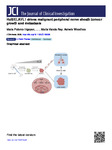HuR/ELAVL1 drives malignant peripheral nerve sheath tumor growth and metastasis
| dc.contributor.author | Palomo-Irigoyen, M | |
| dc.contributor.author | Pérez-Andrés, E | |
| dc.contributor.author | Iruarrizaga-Lejarreta, M | |
| dc.contributor.author | Barreira-Manrique, A | |
| dc.contributor.author | Tamayo-Caro, M | |
| dc.contributor.author | Vila-Vecilla, L | |
| dc.contributor.author | Moreno-Cugnon, L | |
| dc.contributor.author | Beitia, N | |
| dc.contributor.author | Medrano, D | |
| dc.contributor.author | Fernández-Ramos, D | |
| dc.contributor.author | Lozano, JJ | |
| dc.contributor.author | Okawa, S | |
| dc.contributor.author | Lavín, JL | |
| dc.contributor.author | Martín-Martín, N | |
| dc.contributor.author | Sutherland, JD | |
| dc.contributor.author | de Juan, VG | |
| dc.contributor.author | Gonzalez-Lopez, M | |
| dc.contributor.author | Macías-Cámara, N | |
| dc.contributor.author | Mosén-Ansorena, D | |
| dc.contributor.author | Laraba, Liyam | |
| dc.contributor.author | Hanemann, Clemens Oliver | |
| dc.contributor.author | Ercolano, E | |
| dc.contributor.author | Parkinson, David | |
| dc.contributor.author | Schultz, CW | |
| dc.contributor.author | Araúzo-Bravo, MJ | |
| dc.contributor.author | Ascensión, AM | |
| dc.contributor.author | Gerovska, D | |
| dc.contributor.author | Iribar, H | |
| dc.contributor.author | Izeta, A | |
| dc.contributor.author | Pytel, P | |
| dc.contributor.author | Krastel, P | |
| dc.contributor.author | Provenzani, A | |
| dc.contributor.author | Seneci, P | |
| dc.contributor.author | Carrasco, RD | |
| dc.contributor.author | Del Sol, A | |
| dc.contributor.author | Martinez-Chantar, ML | |
| dc.contributor.author | Barrio, R | |
| dc.contributor.author | Serra, E | |
| dc.contributor.author | Lazaro, C | |
| dc.contributor.author | Flanagan, AM | |
| dc.contributor.author | Gorospe, M | |
| dc.contributor.author | Ratner, N | |
| dc.contributor.author | Aransay, AM | |
| dc.contributor.author | Carracedo, A | |
| dc.contributor.author | Varela-Rey, M | |
| dc.contributor.author | Woodhoo, A | |
| dc.date.accessioned | 2020-07-09T06:57:26Z | |
| dc.date.issued | 2020-06-15 | |
| dc.identifier.issn | 0021-9738 | |
| dc.identifier.issn | 1558-8238 | |
| dc.identifier.uri | http://hdl.handle.net/10026.1/15871 | |
| dc.description.abstract |
Cancer cells can develop a strong addiction to discrete molecular regulators, which control the aberrant gene expression programs that drive and maintain the cancer phenotype. Here, we report the identification of the RNA-binding protein HuR/ELAVL1 as a central oncogenic driver for malignant peripheral nerve sheath tumors (MPNSTs), which are highly aggressive sarcomas that originate from cells of the Schwann cell lineage. HuR was found to be highly elevated and bound to a multitude of cancer-associated transcripts in human MPNST samples. Accordingly, genetic and pharmacological inhibition of HuR had potent cytostatic and cytotoxic effects on tumor growth, and strongly suppressed metastatic capacity in vivo. Importantly, we linked the profound tumorigenic function of HuR to its ability to simultaneously regulate multiple essential oncogenic pathways in MPNST cells, including the Wnt/β-catenin, YAP/TAZ, RB/E2F, and BET pathways, which converge on key transcriptional networks. Given the exceptional dependency of MPNST cells on HuR for survival, proliferation, and dissemination, we propose that HuR represents a promising therapeutic target for MPNST treatment. | |
| dc.format.extent | 3848-3864 | |
| dc.format.medium | ||
| dc.language | en | |
| dc.language.iso | en | |
| dc.publisher | American Society for Clinical Investigation | |
| dc.rights | Attribution-NonCommercial-NoDerivatives 4.0 International | |
| dc.rights | Attribution-NonCommercial-NoDerivatives 4.0 International | |
| dc.rights | Attribution-NonCommercial-NoDerivatives 4.0 International | |
| dc.rights | Attribution-NonCommercial-NoDerivatives 4.0 International | |
| dc.rights | Attribution-NonCommercial-NoDerivatives 4.0 International | |
| dc.rights.uri | http://creativecommons.org/licenses/by-nc-nd/4.0/ | |
| dc.rights.uri | http://creativecommons.org/licenses/by-nc-nd/4.0/ | |
| dc.rights.uri | http://creativecommons.org/licenses/by-nc-nd/4.0/ | |
| dc.rights.uri | http://creativecommons.org/licenses/by-nc-nd/4.0/ | |
| dc.rights.uri | http://creativecommons.org/licenses/by-nc-nd/4.0/ | |
| dc.subject | Cancer | |
| dc.subject | Cell Biology | |
| dc.subject | Epigenetics | |
| dc.subject | Oncogenes | |
| dc.subject | Oncology | |
| dc.subject | Animals | |
| dc.subject | Carcinogenesis | |
| dc.subject | Cell Line, Tumor | |
| dc.subject | Cell Proliferation | |
| dc.subject | ELAV-Like Protein 1 | |
| dc.subject | Humans | |
| dc.subject | Mice | |
| dc.subject | Neoplasm Metastasis | |
| dc.subject | Neoplasm Proteins | |
| dc.subject | Nerve Sheath Neoplasms | |
| dc.subject | Signal Transduction | |
| dc.title | HuR/ELAVL1 drives malignant peripheral nerve sheath tumor growth and metastasis | |
| dc.type | journal-article | |
| dc.type | Journal Article | |
| dc.type | Research Support, N.I.H., Intramural | |
| dc.type | Research Support, Non-U.S. Gov't | |
| plymouth.author-url | https://www.webofscience.com/api/gateway?GWVersion=2&SrcApp=PARTNER_APP&SrcAuth=LinksAMR&KeyUT=WOS:000579392400005&DestLinkType=FullRecord&DestApp=ALL_WOS&UsrCustomerID=11bb513d99f797142bcfeffcc58ea008 | |
| plymouth.issue | 7 | |
| plymouth.volume | 130 | |
| plymouth.publication-status | Published | |
| plymouth.journal | Journal of Clinical Investigation | |
| dc.identifier.doi | 10.1172/jci130379 | |
| plymouth.organisational-group | /Plymouth | |
| plymouth.organisational-group | /Plymouth/Faculty of Health | |
| plymouth.organisational-group | /Plymouth/Faculty of Health/Peninsula Medical School | |
| plymouth.organisational-group | /Plymouth/REF 2021 Researchers by UoA | |
| plymouth.organisational-group | /Plymouth/REF 2021 Researchers by UoA/UoA01 Clinical Medicine | |
| plymouth.organisational-group | /Plymouth/Research Groups | |
| plymouth.organisational-group | /Plymouth/Research Groups/Institute of Translational and Stratified Medicine (ITSMED) | |
| plymouth.organisational-group | /Plymouth/Research Groups/Institute of Translational and Stratified Medicine (ITSMED)/CBR | |
| plymouth.organisational-group | /Plymouth/Users by role | |
| plymouth.organisational-group | /Plymouth/Users by role/Academics | |
| plymouth.organisational-group | /Plymouth/Users by role/Researchers in ResearchFish submission | |
| dc.publisher.place | United States | |
| dcterms.dateAccepted | 2020-04-14 | |
| dc.rights.embargodate | 2020-7-10 | |
| dc.identifier.eissn | 1558-8238 | |
| dc.rights.embargoperiod | Not known | |
| rioxxterms.versionofrecord | 10.1172/jci130379 | |
| rioxxterms.licenseref.uri | http://creativecommons.org/licenses/by-nc-nd/4.0/ | |
| rioxxterms.licenseref.startdate | 2020-06-15 | |
| rioxxterms.type | Journal Article/Review |



